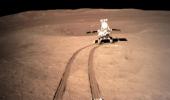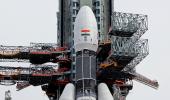China's Chang'e-5 probe successfully touched down on Earth in the early hours of Thursday, bringing home the first samples of the moon in over 40 years.

The spacecraft landed in Siziwang Banner in north China's Inner Mongolia Autonomous Region at 1:59 am (local time), according to the China National Space Administration.
Zhang Kejian, head of the CNSA, declared the Chang'e-5 mission a success.
It marks a successful conclusion of China's current three-step lunar exploration programme of orbiting and landing, and bringing back samples which began in 2004, state-run Xinhua news agency reported.
China’s President Xi Jinping congratulated scientists on the complete success of the Chang'e-5 mission.
As China's most complicated space project, Xi in his message to the CNSA said, the Chang'e-5 mission "is another major achievement in overcoming difficulties by giving full play to the advantages of the new system of pooling national resources and strength, marking a great step forward in China's space industry".
"This will contribute to deepening the understanding of the origin of the moon and the evolution history of the solar system," he said, adding that "your remarkable feats will always be remembered by our country and people."
The Chang'e-5 space mission is China's maiden attempt to retrieve materials from an extra-terrestrial body. It was launched on November 24.
It was the first attempt to bring the moon samples in over 40 years after the US sent astronauts to the moon to collect samples. In the Soviet Union's unmanned lunar sampling missions, the spacecraft took off from the moon and returned to Earth directly.
Commenting on Chang'e-5 mission, Dr Jonathan McDowell, Astronomer, Centre for Astrophysics, Harvard and Smithsonian, said it is the most ambitious space programme China has accomplished so far.
"They have done a whole rehearsal mission way back in 2014. So, they have been preparing for this moment for a long time. The fact that it went off so successfully is going to give them confidence even more ambitious missions in future," he told BBC.
He also said through such mission China is making a political and strategic statement to the world.
"In terms of launch rates, they are launching as many rockets as US space missions. It has been huge investments on their part and very impressive ramp up of their industrial capacity. They really see this is way to prove that they are at the forefront as a nation in technology," he said.
On Wednesday night, the return capsule of Chang'e-5 separated from the orbiter about 5,000 km above the Atlantic. The capsule entered the Earth's atmosphere at an altitude of about 120-km. At about 10 km above ground, a parachute opened.
The capsule landed smoothly in the predetermined area and the search team recovered it, the Xinhua said.
The capsule is set to be airlifted to Beijing for opening, and the moon samples will be delivered to the research team for analysis and study, the CNSA said.
China will make some of the samples available to scientists in other countries, said Pei Zhaoyu, deputy director of the Lunar Exploration and Space Program Center of CNSA.
Chang'e-5 is one of the most complicated and challenging missions in China's aerospace history as it touched down on the north of the Mons Rumker in Oceanus Procellarum, also known as the Ocean of Storms, on the near side of the moon on December 1, the report said.
This site was chosen because it had a younger geological age than the sampling areas of the US and the Soviet Union more than 40 years ago, and had never been sampled. The new samples reportedly weighing about two kg will be of great scientific value, according to Chinese space scientists.
Chinese space officials say though lunar samples were brought back in the US and Soviet missions, scientists need more samples of different ages to piece together a complete history of the moon.
Chang'e-5 drilled into the lunar surface for samples that record evolutionary events, and grabbed material on the surface. Using modern analytical technologies, scientists will be able to unravel the mysteries of volcanic activities and meteorite impacts over the past billion years, the report said.
The probe has collected material at different sites to ensure the diversity of the samples.
Pei said China is drawing up plans for future lunar exploration, including constructing a basic version of a scientific research station, he said.
“We hope to cooperate with other countries to build the international lunar scientific research station, which could provide a shared platform for lunar scientific exploration and technological experiments," Pei said.
Meanwhile, China's Mars probe Tianwen-1 is currently more than 100 million kms away from Earth and is functioning normally, the CNSA said on Tuesday.
The US, Russia, the European Union besides India have so far succeeded in sending missions to Mars which is regarded as the most complex space mission.
India became the first Asian country to have successfully launched its Mars orbiter mission, Mangalyaan, which entered the orbit of the red planet in 2014.
India also became the first country to have entered the Martian orbit in its first attempt.










 © 2025
© 2025